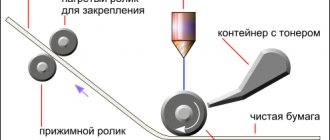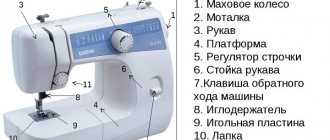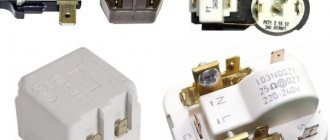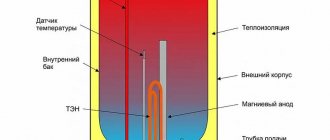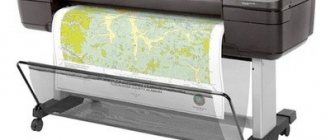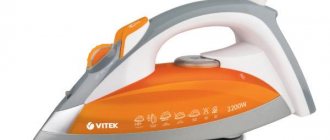Engine location
The horizontal layout is used, while in light hammer drills it is vertical. medium not heavy. However, there are no exceptions. Heavy hammer drill
Metabo KHE ninety-six, weighing almost twelve kg, has a horizontal engine.
A tool with a horizontal layout is more compact and not convenient for working in narrow spaces. However, this design is characterized by an increased shock load on the engine and somewhat worse cooling conditions.
The vertical layout provides better engine operating conditions (reduced shock vibration and effective cooling), in addition, a wider range of motion of the piston without the striker due to the ability to use it instead of an oscillating bearing
crank mechanism with increased piston stroke.
Rotary hammers with a vertical engine can withstand more intense work than models with a horizontal layout.
Cartridges for rotary hammers
Structurally, rotary hammers use two main types of cartridges - SDS-plus and SDS-max. There are other types, but these two types of executive bodies are considered the most popular and effective. SDS-plus is used on household and semi-professional units, and SDS-max on professional hammer drills.
The only thing that should be noted in the material is that the attachments in such chucks are not fixed rigidly, as in collet chucks. The nozzle installed in the chuck has free movement, which plays an important role for the impact mechanism. It is due to this stroke that impacts are made on the surface being treated.
Fixation of the nozzles is ensured by slots, the number of which is two in SDS-plus cartridges, and three in SDS-max devices. These splines act as guides and also allow the drill bits to rotate with the chuck. In addition to slots, the design of the devices includes balls (in SDS-plus cartridges) and rollers (SDS-max). They engage with grooves in the design of the nozzle shanks. It is due to the balls and rollers that the movable fixation of the attachments is ensured.
So, having understood the design of a power tool, it’s time to move on to the question of how a hammer drill works. The principle of its operation is simple, but it is impossible to understand it without disassembling the power tool. To do this, you will need to disassemble the tool and examine the component parts. To avoid having to disassemble the hammer drill, let’s find out how it works using a photo description.
Impact mechanism
There are two main versions of the shock electro-pneumatic mechanism. using a swinging (drunk) bearing, in other words, a crank mechanism. Instructions and video
on the topic of how to properly disassemble
hammer drill
repair. The first option is used for light and, in part, medium hammer drills, the second. for medium not heavy.
The figure below shows a diagram of a light-type rotary hammer. Its impact mechanism consists of an oscillating bearing
, piston, ram is not striker.
During operation of the hammer drill, rotation from the electric motor is transmitted to the inner sleeve of the swing bearing . At the same time, its outer sleeve, together with a perpendicular axis connected to the piston, performs oscillatory movements. Between the piston and the ram there is an air space, which, thanks to the increased pressure and rarefaction created here alternately, forces the ram to repeat the oscillatory movements of the piston, striking the striker. The latter again hits the tool located in the chuck. Thus, the energy of the electric motor is transformed into the impact energy of the tool.
The pneumatic impact mechanism is equipped with a self-shutoff function when idling. Office, when the tool (drill, drill, bit) is not pressed to the surface being processed, the ram moves forward, opening a hole in the body for air to enter and exit. And therefore, this compression and vacuum are not created in the working air cavity, it is turned off, and the hammer drill
works without shocks. When the tool is pressed on the surface being processed, the hole is blocked by the ram, compression occurs in the air cavity, and the non-impact mechanism begins to function.
How to use a hammer drill correctly
To ensure that the tool serves you for as long as possible, use it only in accordance with the instructions. If the manufacturer recommends pausing during operation, it means that the mechanisms expand when heated and may break.
It is unacceptable to use more powerful drills and chisels using adapters. Heavier work should be performed with appropriate tools. Saving when buying a lightweight hammer drill will lead to its rapid breakdown and loss of financial resources.
How does a hammer drill work? What's inside a hammer drill? Using the DeWALT D25603K rotary hammer as an example
How does a hammer drill
?
What happens inside a hammer drill? How does a hammer drill
? Operating principle of perforations
In medium and heavy hammer drills with a vertical engine layout, the piston is driven by a crank mechanism. The increased amplitude of movement of the pistons contributes to a higher impact power, which for heavy hammer drills can reach twenty J. The operation of the impact mechanism occurs in the same way as described above.
At the end of the article there is a video demonstrating the operation of the impact mechanism.
The figure below shows the structure of a domestically produced hammer drill Progress PE-40/1050, with a power of one thousand fifty W with a vertical engine and a crank drive of the impact mechanism. Rotation from the engine is transmitted through a worm shaft to a helical gear, on the shaft of which there is a crank that drives the piston.
What's inside the hammer drill
Structurally, the hammer drill consists of two main parts - electrical and mechanical. Depending on the location of the electric motor, rotary hammers are of direct or pistol type, as well as barrel ones. In pistol hammer drills the electric motor is located horizontally, and in barrel hammers it is located vertically.
On rotary hammers, as well as grinders, drills and other power tools, commutator electric motors are used. They consist of two main components - a stator and a rotor. The stator is a stationary part that consists of copper windings and steel plates. The stator windings create a constant electromagnetic field, which drives the rotor.
The rotor or armature is the moving part of an electric motor, which also consists of a copper winding wound on a steel core. The rotor rotates inside the stator. The rotor windings are connected to commutator plates, which are also supplied with current through graphite brushes. A slip field is created in the electric motor, which helps drive the rotor. A gear is attached to the rotor shaft, which drives the gearbox.
Safety clutch
Two types of clutches are used as safety clutches in rotary hammers: friction and spring-cam. The former consist of disks that are normally pressed against each other and transmit torque. When the tool jams, the disks slide relative to each other, disconnecting the motor shaft from the chuck with the attachment. The friction clutch is used, for example, in models from Metabo.
Many companies use spring-cam type safety clutches. They consist of two coupling halves with radially located projections and depressions (teeth) at the ends, which are aligned under normal conditions. The clamping of the coupling halves to each other is ensured by a spring. The principle of operation of a spring-claw coupling is based on the slipping of the coupling halves relative to each other in the event that the moment of resistance begins to exceed the pressing force of the spring. At the same time, a characteristic cracking sound is heard, signaling that the nozzle is jammed.
It is believed that a spring-cam clutch is more reliable than a friction clutch, however, it also has a serious drawback. It consists in the fact that the tips of the teeth are rolled, which leads to the coupling being activated even in the case when the nozzle is not jammed, but only a lot of resistance has arisen. Some craftsmen cope with this problem by placing a 3-5 mm thick washer under the spring, which increases the compression force of the spring and, consequently, the moment of actuation of the clutch. However, excessive rigidity of the coupling is also undesirable, since it makes the tool jerk too much when the attachment jams, which can lead to injury to the hands of people working with the hammer drill.
How does the tool work?
You can find a huge number of rotary hammers with a variety of designs on the market. But regardless of the many modifications of the device, they all consist of approximately the same components.
Electric drive
The hammer drill is equipped with an electric drive as a motor. Typically commutator type drives are used. In light models that are purchased for work in domestic conditions, the engine is in a horizontal position. In medium and heavy ones it is fixed vertically.
Horizontal arrangement
Devices with horizontal drive are considered more compact and convenient when working in hard-to-reach places.
But this design also has its drawbacks.
For example, due to its location, the drive is poorly cooled, and its power component is subject to high loads.
But devices with a vertical drive are cooled much better. In addition, their design implies a reduced level of shock vibration. Also, thanks to the vertical placement, it allows you to give the piston a wide amplitude of movement, which also increases the amplitude of the striker. This advantage is explained by the fact that in a vertical arrangement a crank mechanism is used. But in devices with a horizontal motor, a rolling bearing is used. Thanks to this, rotary hammers with vertical motors are able to work much longer.
Impact mechanism design
The impact mechanism allows the hammer to perform its main function (drilling). The tool uses two main types:
The first type of mechanism is used in most modern instrument models. Its main advantage is high impact energy with low power of the power structure. There are two types of electro-pneumatic mechanism. The first uses a rolling bearing (for light models), and the second uses a crank mechanism for heavy and medium models.
Impact mechanism diagram
Among the elements of the impact mechanism are the rolling bearing, ram, piston and firing pin.
During the start of operation, the impact force from the electric motor is applied to the inner race of the bearing.
At the same time, the outer ring begins to produce oscillatory movements. The internal volume of air between the ram and the piston is alternately under high and low pressure conditions. At this time, the ram repeats the movements behind the piston and hits the firing pin, which, in turn, hits the nozzle in the cartridge.
The pneumatic operating mechanism allows the device to turn off during idling. This became possible due to the displacement of the ram forward if there is no contact between the surface and the bit. During the movement of the ram, a hole opens to connect air from the piston chamber with the external environment.
The crank mechanism in rotary hammers operates with a high amplitude, which makes it possible to significantly increase the impact power (up to 20 kJ). The mechanism itself functions in almost the same way as the previous one. The torsional impulse is transmitted from the worm shaft to the gear, and then the crank sends it to the impact mechanism.
Anti-vibration system
Companies are constantly developing new systems that will improve the mechanism and reduce the amount of vibration received by the tool. All existing technologies can be divided into two types:
An active vibration protection system is installed only on high-power rotary hammers. They use a mechanism consisting of a counterweight and a spring device. This technology cannot completely extinguish all generated vibrations, but it significantly reduces their level. Also, to perform this task, she is helped by the handle of the device, which is attached to the body of the hammer drill using a hinge and springs.
The passive vibration damping system uses rubber pads on the housing. They also prevent your hands from slipping when working with a hammer drill. This system is less efficient.
Electrical circuit and housing
Several methods are used to control the speed of rotation of the bits on a rotary hammer. Most often, to do this, the master must change the force of pressing the start button. In some models, this is done using a regulator knob that must be turned. The electrical circuits of different models differ significantly from each other. Most often they are very similar to the design of an electric drill.
The body of the hammer drill is made of metal. Typically, an alloy of aluminum or magnesium is used for its production. In lightweight hammer drills, the body is made of impact-resistant plastic. Some models can be made of both metal and plastic. Metal in such a device is also necessary for rapid cooling of the system.
Air is used to effectively cool the entire system. It is delivered to the impact mechanism using a fan located next to the electric motor. This design avoids overheating of the device. The powerful air flow allows you to maintain the required temperature of the entire hammer drill and avoid injuries when working with it. In some models, areas that heat up the most are protected with plastic pads. In other devices, for this purpose, the body is made of metal on one side, and durable plastic on the other.
Safety clutch
To protect the device from damage when the cartridge jams, special couplings are used in rotary hammers. It also helps avoid injury during use and eliminates the risk of overloading the entire system. If the drill suddenly stops, the clutch protects the motor armature from stopping. It allows the hammer drill chuck to detach from the shaft and prevents it from burning out.
The most common types of couplings for hammer drills are:
The first type is made of a group of disks connected to each other. When the cartridge stops, they slip, which helps the cartridge separate from the other cartridge. The second mechanism has two coupling halves with special pits and elevations at the ends. They are connected to each other using a spring. The method of operation is the same as in the previous version. If the sliding mechanism has worked, the hammer produces a strong cracking sound of teeth.
The spring-cam system has been found to be safer for use in rotary hammers. But it also has one significant drawback. During operation, the ends of the protrusions on the coupling halves may become rolled, which leads to the involuntary activation of the mechanism unnecessarily.
Gearbox
The gearbox is used to send a torsional impulse to the hammer drill chuck. It also helps the percussion mechanism operate. The gearbox housing includes several types of gears. They have a constant gear ratio. Some types of tools include two-speed gearboxes. For reliability, grease is used, which is poured during the assembly of the device or during its repair. The number of revolutions of the hammer drill is set using an electronic regulator.
Cartridge
In most hammer drills, manufacturers use three types of cartridges. They have the following design:
A jaw chuck is also called a key chuck. When using it, the attachments are clamped using a key that allows you to compress and unclench the cams. In the quick-release chuck, the attachments are secured only with the help of your hands. This design can be single-coupled or double-coupled. They are used on rotary hammers with automatic shaft locking. The most common is the SDS system; it is included in the design of 90% of modern instruments.
Read also: Machine for tightening car strut springs
Hammer. Types and device. Operation and application. Peculiarities
A hammer drill is a tool designed for making holes. Its operation is ensured by the simultaneous impact-translational and rotational movement of the drill. Unlike drilling, the hole is not cut by the sharp edge of the drill, but is made by mechanized rotation of the working element. To create the impulse that is necessary for the operation of the tool, a pneumatic or, in rare cases, an electromagnetic mechanism is used. In application and design it is similar to a drill.
Kinds
Depending on the type of drive, the hammer drill is:
- Corded Electrical Tools . This is the most common type; their electric motor can be located both vertically and horizontally.
- Cordless electric tools . They are convenient for working in places where there is no electrical network. The battery on such units is in most cases located directly on the body of the power tool.
- Pneumatic tools . They are used to work in unsafe environments. For example, if there is a danger of a gas explosion, because the slightest spark can lead to an explosion. Or when working in a damp environment, as the likelihood of electric shock increases significantly.
- Gasoline . They are best suited for on-site road work.
Depending on the type of work, a hammer drill can be industrial or household. Most of them are industrial. Household appliances are typically used for moderate-duty jobs.
Based on its weight, a hammer drill can be of three types:
- Lightweight - up to 3 kg. It is used to create a small hole for an anchor or dowel.
- Medium - up to 5 kg. Used for chiseling reinforced structures. Can be used for processing high hardness stone.
- Heavy - over 5 kg. This tool can replace even a small jackhammer. It is often used for impact drilling of concrete having a thickness of 30-60 mm.
The division also occurs according to the modes used:
- Single-mode tools - used only for drilling.
- Dual-mode - used when drilling with impact is necessary;
- Three-mode - in addition to conventional drilling and drilling with impact, they are used for chiselling.
Device
Depending on the functionality, manufacturer and power of the tool, its design features may vary. However, despite this, the main elements remain unchanged:
- The main element is the electric motor, which can be made in a vertical (heavy and medium) or horizontal (light) design. The horizontal layout ensures the compactness of the device, but this design involves a high shock load on the motor. The vertical design ensures efficient cooling of the engine, thereby improving the quality of its operation. This layout is best suited for intensive work.
- The most important component is the impact mechanism. It can be pneumatic, mechanical or electromechanical.
- Gearbox. It is used to transmit torque to the chuck axis from the engine and simultaneously reduce the rotation speed.
- Anti-vibration system. It has a significant impact on the quality of the work performed, including the health of the craftsman who works with the tool.
- The body of the device, which is made of impact-resistant plastic or metal.
- Electrical diagram. Used to control the rotation speed of the motor.
- The safety clutch allows you to stop the chuck in a situation where the tool jams in the hole. It provides protection to a person's hands from possible injuries.
Additionally, the hammer drill can be equipped with additional systems that make the use of the device comfortable or expand its capabilities. These include:
- Mechanism for fixing drilling depth.
- Work element fixation system.
- System for removing dust generated in the work area.
- The mechanism for changing the operating modes of the tool and so on.
Operating principle
The operating principle of the tool is based on a percussion mechanism - pneumatic, hydraulic, mechanical or electromagnetic. The impact mechanism itself is driven by the rotational motion of the motor. The electromagnetic mechanism involves the operation of two electromagnetic coils. They ensure the movement of the core in a reciprocating direction. In this case, the core transmits these impacts to the end part of the drill. The pneumatic version is provided by the movement of the piston in a reciprocating direction in the cylinder.
The pneumatic system of this unit has 2 design options - using a swing bearing, as well as a crank mechanism, which is combined with the gear part. When the shaft rotates, oscillatory rotations of the piston are formed, which pumps air into the working cylinder of the system. Due to the small space, the cylinder generates compressed air pressure, which leads to the movement of the ram and the striker.
Due to short-term impulse transitions of the ram and piston, these movements are converted into impacts. When idling, the mechanism, being not pressed against a hard surface, turns itself off, as a result, compression pressure is not generated, and no shocks are produced. The working mechanism itself is motionless. The rotation speed of the shaft can be adjusted by pressing a button if there is a soft start. In a number of models, the button is equipped with a regulator for setting the maximum trigger pull, which allows you to set the power and engine speed.
More complex electronic systems can be used - constant electronics. It maintains the specified impact energy, torque and speed under load. As a result, there is no drop in performance under heavy loads, especially at reduced speeds. In “advanced” models, armature rotation is controlled and a power reserve is activated in the event of an increase in load.
To protect the user from injury due to jamming of the tool, a safety clutch or release clutch is used, which immediately locks. It ensures that the shaft is disconnected from the gearbox.
The tool often has to work with materials that generate a significant amount of abrasive particles and dust. They interfere with the user's work and contribute to wear on the tool barrel. To eliminate this, a number of models are equipped with dust extraction systems that suck dust from the work area.
Application
The hammer drill is used to create holes in concrete, stone, and brick building structures of increased strength by applying mechanical blows to the nozzle, which performs a combined translational and rotational movement.
In addition, the tool can be used for the following operations:
- Applying axial blows in jackhammer mode.
- Drilling holes in various materials using the drill function.
To ensure versatility, many manufacturers provide the tool with additional functions and offer a set of special attachments that allow:
- Prepare different construction solutions.
- Drill holes.
- Perform grinding.
- Clean concrete, stone and metal surfaces.
- Perform many other tasks.
Additional functions
Considering the principle of operation of the hammer drill’s impact mechanism, it should be noted that there are several additional modes. Thus, the presence of idle speed is provided. In this case, the mechanism does not press against a hard surface and turns itself off. Therefore, no compression pressure occurs. In this case the blows stop.
The working mechanism is stationary. In this case, the shaft speed can be adjusted. There is a button on the case for this purpose. The launch is smooth. In most modern models, the button is supplemented with a trigger pressure limit regulator. This allows you to set the speed and power of the electric motor.
To protect the technician from injury, a special protective coupling is used. It is triggered if the tool jams while drilling. At this moment, the coupling disconnects the shaft from the gearbox. The mechanism immediately stops.
